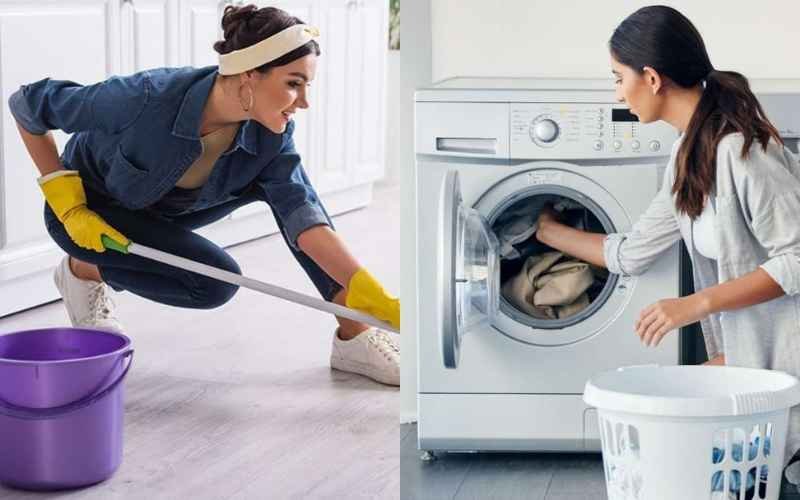In our busy lives, finding time for a dedicated workout can be challenging. However, did you know that you can incorporate calorie-burning activities into your daily routine without stepping foot in a gym? Household chores, often seen as mundane tasks, can actually help you burn calories and melt fat effectively. Here are five household chores that double as workouts, turning your home into a calorie-burning haven.

1. Vacuuming: A Full-Body Workout
Vacuuming might seem like a simple chore, but it engages multiple muscle groups, making it a great full-body workout. Here’s how this everyday activity can contribute to your fitness routine:
Muscle Engagement
- Arms and Shoulders: Pushing and pulling the vacuum cleaner involves the biceps, triceps, and shoulder muscles. The repetitive motion can help tone and strengthen these muscles over time.
- Core: Maintaining a stable posture while vacuuming requires core strength. Your abdominal and lower back muscles work to keep you balanced and upright, contributing to a stronger midsection.
- Legs and Glutes: Moving around the house, especially if you have to bend, reach, or navigate stairs, engages your leg muscles, including the quadriceps, hamstrings, and glutes. These movements help in toning and strengthening the lower body.
Cardiovascular Benefits
- Increased Heart Rate: Vacuuming is a form of moderate aerobic exercise. The constant movement raises your heart rate, enhancing cardiovascular health.
- Step Count: As you move from room to room, your step count increases, contributing to your daily physical activity goals. This aspect makes vacuuming a low-impact cardio workout, beneficial for overall fitness.
Calories Burned
- Approximate Caloric Burn: Vacuuming can burn approximately 180-200 calories per hour. The exact number can vary based on factors like your weight, intensity of the activity, and duration.
Maximizing the Workout
- Long, Deliberate Strokes: Using longer strokes instead of quick, short ones can enhance the muscle engagement, making the workout more effective.
- Switch Hands: Periodically switching hands while vacuuming ensures that both sides of your body get equal exercise, promoting balanced muscle development.
- Posture and Movement: Maintain good posture by keeping your back straight and engaging your core. Also, vary your movements by including lunges or squats while vacuuming to target different muscle groups.
Additional Tips
- Warm-Up: Consider doing a quick warm-up before starting to prevent any muscle strain.
- Hydration: Keep yourself hydrated, as vacuuming for extended periods can be physically demanding.
- Music and Motivation: Playing your favorite upbeat music can make the activity more enjoyable and keep you motivated to continue moving.
Incorporating vacuuming into your regular cleaning routine not only keeps your home tidy but also contributes to your physical fitness, making it a win-win activity.
2. Mopping: Core and Upper Body Strengthening
Mopping the floors is more than just a cleaning task; it can also serve as an effective workout, particularly for your core and upper body. Here’s how mopping contributes to physical fitness:
Muscle Engagement
- Core: The twisting motion required to wring out the mop engages your oblique muscles and overall abdominal region. This constant twisting and turning helps strengthen and tone your core muscles.
- Arms: The repetitive scrubbing action uses the biceps, triceps, and shoulder muscles. The resistance from the mop against the floor adds an element of strength training to this activity.
- Back: Keeping a proper posture while mopping works the muscles in your lower and upper back, contributing to a stronger and more stable spine.
Cardiovascular Benefits
- Moderate Aerobic Exercise: Mopping is a moderate-intensity aerobic exercise. The continuous movement keeps your heart rate elevated, which is beneficial for cardiovascular health.
- Flexibility and Mobility: The stretching and reaching involved in mopping enhance flexibility and improve overall mobility.
Calories Burned
- Approximate Caloric Burn: Mopping can burn around 170-200 calories per hour. This caloric expenditure makes it a beneficial activity for weight management and overall fitness.
Maximizing the Workout
- Add Dance Moves: Incorporating dance moves into your mopping routine can make the activity more enjoyable and increase calorie burn. Dancing engages additional muscle groups and enhances the cardiovascular benefits of mopping.
- Proper Form: Ensure you maintain a good posture by keeping your back straight and engaging your core muscles throughout the activity.
- Use Both Hands: Switching hands periodically ensures balanced muscle development and prevents overuse injuries on one side of your body.
- Vary Your Movements: Including lunges, squats, or side steps while mopping can target different muscle groups and intensify the workout.
Additional Tips
- Warm-Up and Stretch: Perform a brief warm-up and some stretches before starting to mop to prepare your muscles and prevent strain.
- Hydration: Stay hydrated by drinking water before, during, and after your mopping session, especially if you’re intensifying the workout.
- Music and Enjoyment: Playing upbeat music can make mopping more fun and keep you motivated to maintain a higher intensity, enhancing both the cleaning and workout aspects of the activity.
3. Gardening: A Natural Fat Burner
Gardening is not just a relaxing hobby; it’s also a fantastic way to burn calories and improve your overall fitness. Here’s how various gardening activities can contribute to your health:
Muscle Engagement
- Legs: Digging and planting require squatting and lunging, which engage your quadriceps, hamstrings, and glutes. These activities help tone and strengthen the lower body.
- Arms and Shoulders: Weeding, raking, and carrying heavy bags of soil or mulch work your biceps, triceps, and shoulder muscles. These repetitive motions help build upper body strength.
- Core: Bending, twisting, and lifting in the garden engage your core muscles, including your abdominals and lower back. This helps improve core strength and stability.
- Back: Activities like digging and lifting also strengthen the muscles in your upper and lower back, promoting better posture and reducing the risk of back pain.
Cardiovascular Benefits
- Moderate to Vigorous Exercise: Gardening can range from moderate to vigorous physical activity, depending on the intensity and duration of the tasks. This helps elevate your heart rate, improving cardiovascular health.
- Continuous Movement: The constant movement in the garden, whether you’re walking, squatting, or bending, contributes to a sustained aerobic workout, which is excellent for overall fitness.
Calories Burned
- Approximate Caloric Burn: Gardening can burn about 200-300 calories per hour. The exact number varies based on the intensity of the activities, your body weight, and the duration of your gardening session.
Maximizing the Workout
- Alternate Tasks: To work different muscle groups and avoid overuse injuries, alternate between tasks. For example, spend 15 minutes digging, then switch to weeding or planting. This keeps your body moving and engaged.
- Proper Technique: Use proper techniques for lifting and bending to avoid strain. Bend your knees and keep your back straight when lifting heavy objects, and avoid twisting your spine awkwardly.
- Pace Yourself: Work at a steady pace to maintain an elevated heart rate and maximize the cardiovascular benefits. Taking short breaks to hydrate is also important to prevent fatigue.
Additional Tips
- Warm-Up and Stretch: Start with a warm-up and some light stretching to prepare your muscles for the physical activity. Focus on stretching your back, legs, and arms.
- Hydration: Gardening can be physically demanding, especially in warm weather. Keep a water bottle nearby and take regular sips to stay hydrated.
- Use Ergonomic Tools: Invest in ergonomic gardening tools to reduce strain on your hands and joints, making your gardening experience more comfortable and efficient.
- Mindful Movements: Be mindful of your movements to avoid injury. Use smooth, deliberate actions instead of sudden, jerky motions, and listen to your body’s signals to prevent overexertion.
4. Window Cleaning: Upper Body and Cardio Exercise
Cleaning windows is not just about getting a sparkling view; it can also provide a beneficial workout, particularly for the upper body and cardiovascular system. Here’s how window cleaning can contribute to your fitness:
Muscle Engagement
- Arms and Shoulders: The stretching and reaching motions involved in cleaning windows effectively work your biceps, triceps, and shoulder muscles. The repetitive circular motion of scrubbing and wiping helps tone and strengthen these muscles.
- Upper Back: Reaching and scrubbing motions engage the muscles in your upper back, contributing to improved strength and posture.
- Core: Maintaining balance while reaching high or awkward spots engages your core muscles, including the abdominals and lower back, helping to strengthen and tone your midsection.
Cardiovascular Benefits
- Moderate Aerobic Exercise: The continuous movement required in window cleaning keeps your heart rate elevated, providing a moderate cardio workout. This is beneficial for cardiovascular health and endurance.
- Full-Body Movement: Moving around the house to clean different windows increases your overall activity level, contributing to better fitness and calorie burning.
Calories Burned
- Approximate Caloric Burn: Window cleaning can burn approximately 180-200 calories per hour. The exact number depends on factors like the intensity of the cleaning, your body weight, and the duration of the activity.
Maximizing the Workout
- Use a Ladder: Incorporating a ladder to reach high windows adds an element of climbing, which provides an additional workout for your legs, especially the quadriceps and calves. Ensure you prioritize safety by using a stable ladder and following proper safety guidelines.
- Full-Range Movements: Make full, deliberate movements when cleaning to maximize muscle engagement. Stretch fully and use both circular and side-to-side motions to work different muscle groups.
- Switch Hands: Alternate hands while cleaning to ensure balanced muscle development and prevent fatigue or overuse injuries on one side of your body.
Additional Tips
- Warm-Up and Stretch: Begin with a warm-up and some stretching exercises, focusing on your arms, shoulders, and back to prepare your muscles for the activity.
- Hydration: Keep a water bottle nearby and take regular sips to stay hydrated, especially if you’re cleaning for an extended period.
- Proper Technique: Use proper techniques to avoid strain. Keep your back straight and engage your core when reaching high or low. Avoid overextending or twisting awkwardly to minimize the risk of injury.
- Safety First: When using a ladder, ensure it is placed on a stable surface. Always follow ladder safety guidelines, such as not overreaching and maintaining three points of contact.
5. Laundry: A Multi-Tasking Calorie Burner
While doing laundry may seem mundane, it’s actually a multi-tasking calorie burner that engages various muscle groups and provides opportunities for cardiovascular activity. Let’s explore how laundry can contribute to your fitness routine:
Muscle Engagement
- Legs: Lifting laundry baskets and bending down to load and unload the washing machine engage your quadriceps, hamstrings, and glutes. Incorporating squats when lifting baskets adds intensity to your leg workout.
- Arms and Shoulders: Carrying laundry baskets, hanging clothes, and folding laundry require the use of your biceps, triceps, and shoulder muscles. These activities help tone and strengthen your upper body.
- Core: Balancing loads, bending, and reaching engage your core muscles, including your abdominals and lower back, contributing to core strength and stability.
Cardiovascular Benefits
- Stair Climbing: Carrying loads of laundry up and down stairs provides a cardiovascular workout, elevating your heart rate and improving endurance.
- Continuous Movement: The repetitive nature of laundry tasks keeps you moving, contributing to sustained aerobic activity.
Calories Burned
- Approximate Caloric Burn: Laundry can burn around 100-150 calories per hour, depending on the intensity and duration of the task. Factors such as the weight of the laundry loads and the number of trips up and down stairs can affect calorie expenditure.
Maximizing the Workout
- Incorporate Squats: When lifting laundry baskets, incorporate squats by bending your knees and keeping your back straight. This not only enhances your leg workout but also promotes proper lifting technique and reduces the risk of injury.
- Multiple Trips: Instead of carrying heavy loads all at once, make multiple trips up and down the stairs. This increases the duration of your cardiovascular activity and helps distribute the workload more evenly.
- Mix Up Tasks: Alternate between different laundry tasks to engage different muscle groups and prevent fatigue. For example, fold a load of laundry before moving on to the next washing or drying cycle.
Additional Tips
- Stretch: Take breaks to stretch your muscles, especially after prolonged periods of bending or lifting. Focus on stretching your arms, shoulders, back, and legs to prevent stiffness and improve flexibility.
- Hydration: Keep a water bottle nearby and stay hydrated throughout your laundry session, especially if you’re sweating or exerting yourself.
- Maintain Proper Posture: Pay attention to your posture when lifting and carrying laundry to avoid strain on your back and shoulders. Keep your spine neutral and use your legs to lift, rather than relying solely on your back muscles.
Conclusion
Incorporating these household chores into your routine not only keeps your home clean and organized but also helps you stay active and burn calories throughout the day. By approaching these tasks with a fitness mindset, you can transform your home into a personal gym, making weight loss and fitness a natural part of your everyday life. So next time you’re cleaning, remember that you’re not just tidying up—you’re working towards a healthier, fitter you!
Top 20 frequently asked questions about weight loss
1. What is the best diet for weight loss?
Answer: There is no one-size-fits-all diet for weight loss. The best diet is one that is balanced, sustainable, and tailored to your individual preferences and needs. Popular diets include the Mediterranean diet, low-carb diets, and plant-based diets.
2. How much weight can I expect to lose in a week?
Answer: A safe and sustainable rate of weight loss is about 1-2 pounds per week. This can vary depending on factors such as your starting weight, diet, and exercise routine.
3. Is it better to lose weight quickly or slowly?
Answer: Slow and steady weight loss is generally more sustainable and healthier. Rapid weight loss can lead to muscle loss, nutritional deficiencies, and other health issues.
4. How important is exercise for weight loss?
Answer: Exercise is crucial for weight loss as it helps burn calories, build muscle, and boost metabolism. Combining regular physical activity with a healthy diet is the most effective way to lose weight.
5. Can I lose weight without exercising?
Answer: Yes, weight loss is possible without exercise by focusing on a healthy, calorie-controlled diet. However, exercise provides numerous health benefits and can aid in maintaining weight loss.
6. What types of exercises are best for weight loss?
Answer: A combination of cardio (e.g., walking, running, cycling) and strength training (e.g., lifting weights, bodyweight exercises) is effective for weight loss. High-Intensity Interval Training (HIIT) is also highly effective.
7. How many calories should I eat to lose weight?
Answer: This varies based on factors like age, sex, weight, height, and activity level. A general guideline is to reduce your daily calorie intake by 500-1,000 calories to lose about 1-2 pounds per week.
8. Are there any foods I should avoid to lose weight?
Answer: Limit foods high in added sugars, refined carbs, and unhealthy fats. Focus on whole, unprocessed foods like vegetables, fruits, lean proteins, and whole grains.
9. Can drinking water help with weight loss?
Answer: Yes, drinking water can help with weight loss by increasing feelings of fullness and boosting metabolism. Aim for at least 8 cups of water per day.
10. How important is sleep for weight loss?
Answer: Sleep is crucial for weight loss. Poor sleep can disrupt hormones that regulate hunger and appetite, leading to increased calorie intake and weight gain.
11. Can stress affect weight loss?
Answer: Yes, chronic stress can lead to weight gain or hinder weight loss by increasing the production of cortisol, a hormone that promotes fat storage, particularly around the abdomen.
12. Are weight loss supplements effective?
Answer: Some weight loss supplements may help, but they are not a magic solution. It’s important to research and consult with a healthcare provider before taking any supplements.
13. How can I stay motivated during my weight loss journey?
Answer: Set realistic goals, track your progress, celebrate small victories, and find a support system. Staying motivated is easier when you have a clear plan and support from others.
14. Is it normal to hit a weight loss plateau?
Answer: Yes, weight loss plateaus are common. To overcome them, try adjusting your diet, changing your exercise routine, or reducing stress.
15. Can intermittent fasting help with weight loss?
Answer: Intermittent fasting can be an effective weight loss strategy for some people. It involves alternating periods of eating and fasting, which can help reduce calorie intake and improve metabolism.
16. How does age affect weight loss?
Answer: As we age, metabolism slows down, and muscle mass decreases, making weight loss more challenging. Adjusting diet and incorporating strength training can help mitigate these effects.
17. Can I lose weight by eating more frequently in smaller portions?
Answer: Eating smaller, more frequent meals can help some people control hunger and prevent overeating. However, the total daily calorie intake is what ultimately matters for weight loss.
18. How can I maintain my weight loss?
Answer: To maintain weight loss, continue eating a balanced diet, stay physically active, monitor your weight regularly, and make healthy lifestyle choices a permanent part of your routine.
19. Is it okay to have cheat days?
Answer: Occasional cheat days can be part of a balanced diet and may help prevent feelings of deprivation. Just be mindful not to overindulge and offset your progress.
20. What is the role of protein in weight loss?
Answer: Protein is essential for weight loss as it helps build and repair muscle, keeps you feeling full, and boosts metabolism. Include lean protein sources like chicken, fish, beans, and tofu in your diet.
Related posts:
 Cardio vs. HIIT: Which Workout is Better for Weight Loss?
Cardio vs. HIIT: Which Workout is Better for Weight Loss?
 Superfood Banana: Know THESE 5 Benefits of Kela
Superfood Banana: Know THESE 5 Benefits of Kela
 When Should You Eat, Before or After Exercise?
When Should You Eat, Before or After Exercise?
 A Comprehensive Diet Plan for Effective Weight Loss
A Comprehensive Diet Plan for Effective Weight Loss
 Skim Milk vs. Whole Milk: Which is Healthier?
Skim Milk vs. Whole Milk: Which is Healthier?
 7 Reasons Why You Must Add Turmeric to Your Diet for Good Gut Health
7 Reasons Why You Must Add Turmeric to Your Diet for Good Gut Health
 10 Quiet Habits Of Successful People, According To Psychology
10 Quiet Habits Of Successful People, According To Psychology
 7 Protein-Rich Snacks to Refuel After Your Workout
7 Protein-Rich Snacks to Refuel After Your Workout
 The Power of Eating a Banana Daily: A Comprehensive Guide
The Power of Eating a Banana Daily: A Comprehensive Guide




